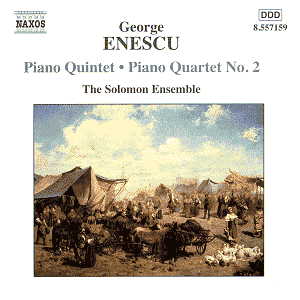Enescuís reputation as a brilliant virtuoso has
long obscured, much to his dismay, his considerable achievement
as a composer. He may be best remembered for his colourful Rumanian
Rhapsodies Op.11 and his Violin Sonata No.3 "dans
le caractère populaire roumain" Op.25. To
limit his compositional achievement to these sole works would
be Ė and definitely is Ė reductive. His early Austro-German training
in Vienna with Helmesberger proved a long-lasting influence on
his music (at least from the formal point of view). This was later
tempered by his studies with Fauré in Paris. In fact, folk-inflected
material tends to be fairly rare in his output, at least in direct
terms. This is best heard in the Rumanian Rhapsodies,
which Ė to some extent Ė are unique in his output, most of which
consists of substantial, large-scale abstract pieces. There are
for example three symphonies, two string quartets, two cello sonatas,
three violin sonatas, a string octet and a Dixtuor for
winds. His oeuvre culminates in the superb opera Oedip.
True, a number of his mature works may still contain some folk-inflected
material but more of the "imaginary folklore" sort,
as in the beautiful and highly original Suite No.3 "Villageoise"
Op.27 for orchestra. These voices can also be heard in
the Third Violin Sonata and the Concert Overture in A major
Op.32. Here the folk music influence is transcended in
much the same way as Bartók did in his mature works. However,
the bulk of his substantial concert works is conspicuously devoid
of any folklore elements. It is characterised by highly elaborate,
contrapuntal structures, often intricately worked-out. The downside
is that Enescuís thematic material may not be particularly distinguished
or arresting, at least at first hearing. As Richard Whitehouse
rightly remarks, "his themes, while rarely drawing attention
to themselves, are capable of far-reaching transformation both
across and between movements". This is certainly true as
regards the two works recorded here.
The Piano Quintet Op.29, though
probably composed in late 1940, was not performed during the composerís
lifetime and its belated premiere took place in 1964! It is a
substantial work in three weighty movements sharing some thematic
material. An emotionally restrained Con moto molto moderato
working-out two main subjects is followed by a long lyrical Andante
of great beauty and harmonic refinement. The quintet ends with
yet another long movement Vivace ma non troppo capped by
an epilogue restating the main themes heard in the course of the
whole work. The music is often very chromatic and densely contrapuntal
as well as quite impassioned at times.
The Piano Quartet No.2 Op.30, completed
in 1943, was written in memory of Fauré, Enescuís teacher
in Paris, on the occasion of the twentieth anniversary of his
death. The overall structure of the piece is roughly similar to
that of the Piano Quintet; and the music is quite similar too
- obviously from the same pen. The beautiful slow movement, may
at times recall Fauré and has a more pronounced Gallic
flavour than the outer movements. This Piano Quartet ends with
a more animated movement bringing an affirmative conclusion.
If you know and love, say, Enescuís string quartets
and cello sonatas, you will know what to expect of these substantial,
if sometimes intricate works, and you will need no further recommendation.
The merits of this disc are all the more compelling given that
the present performances are really very fine. These players obviously
put their hearts into such committed and convincing readings of
works that do not yield all their secrets in a single hearing.
Clean and, to some tastes, close recording and excellent notes
by Richard Whitehouse and Keith Anderson complete the picture.
I should however point out that the formerís comments on the Piano
Quintet are a bit misleading (as if a paragraph on the slow movement
was missing) and the latterís more general introduction has a
slight mistake: Enescuís first major work is Poème
roumain Op.1 (not romaine as stated). These are
minor quibbles that should not deter anyone from investigating
this most welcome release. It adds considerably to oneís appreciation
of Enescuís compositional achievement.
Hubert Culot

